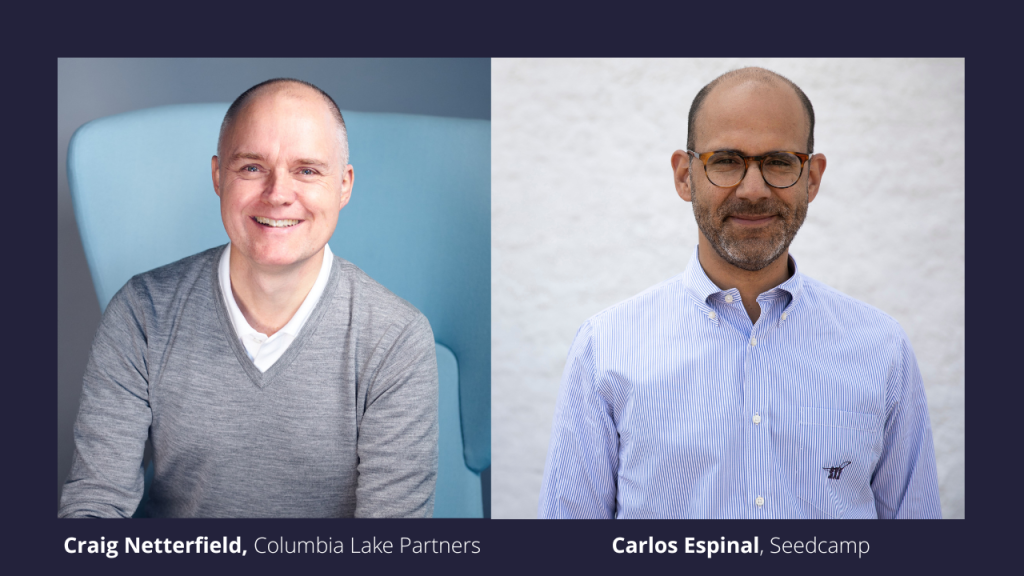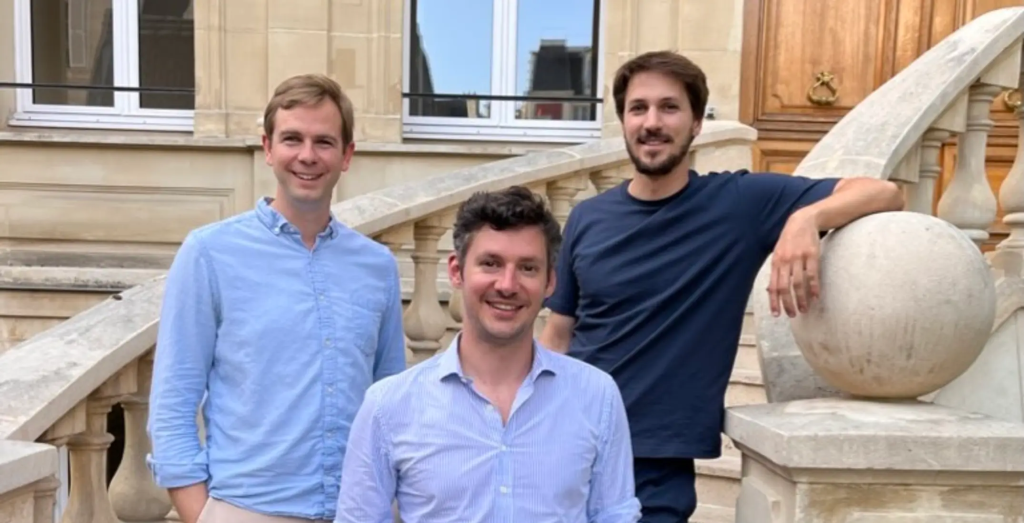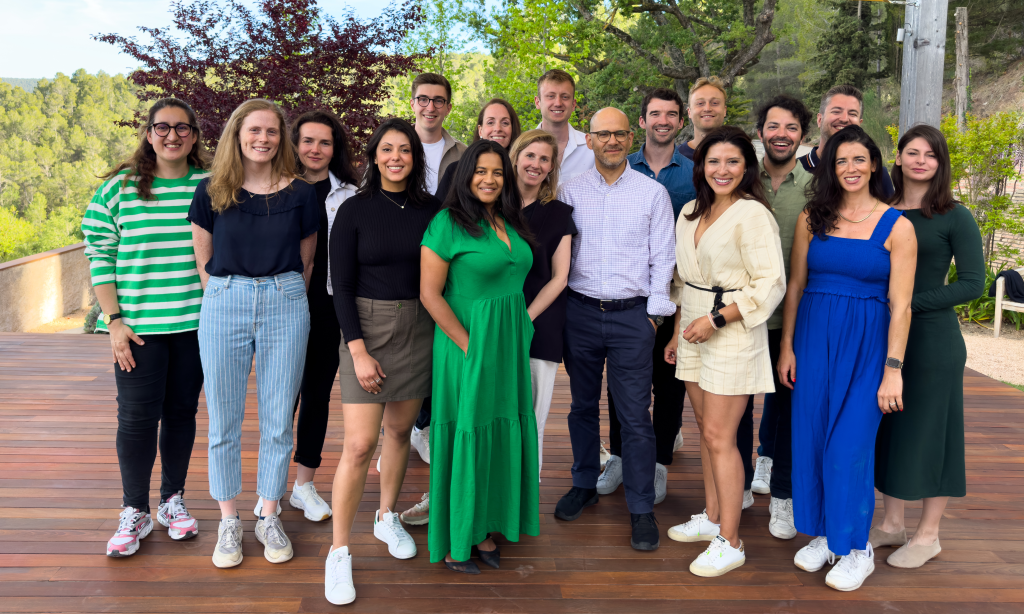In the current surging rates environment, raising capital from VCs or angels has become increasingly expensive for companies, leading many founders to delay raising new rounds or to look for alternative sources of capital as the end of their runways loom.
Venture debt is one source of alternative financing that founders are increasingly turning to. Our Managing Partner Carlos Espinal chatted with Craig Netterfield from European venture debt specialist Columbia Lake Partners about:
– What exactly venture debt is?
– What type of companies venture debt is suitable for?
– How they “operate like a VC, but give loans rather than take equity”.

Carlos: How is venture debt different from traditional banking debt?
Craig: Traditional banks and venture lenders differ in three key areas:
Most traditional banks will only consider assets (real estate, accounts receivable, re-sellable inventory, or machinery) as collateral for a loan. Less traditional banks will also view positive cash flow, even from asset-light companies, as collateral. Most banks will typically not loan to any loss-making companies.
Venture lenders typically lend to a much larger range of companies. This includes companies that are making losses if the cause of the losses is to increase enterprise value, for example, by growing revenues, creating intellectual property, or both.
Banks typically require loanees to keep cash deposits in an account at the lending firm. They also commonly use financial covenants as tools to help them manage the risk of their loans.
Venture lenders won’t use financial covenants to protect their loans. Companies that are considering venture debt need the flexibility to adjust their operations quickly in response to market conditions. In my experience, financial covenants can often incorrectly signal a company is underperforming. These “false positives” cause loan defaults and angst for management and VC shareholders.
Venture lenders also do not require portfolio companies to deposit cash in specific institutions. Firms are free to bank with whomever they choose. The importance of this flexibility was seen most recently with the failure of Silicon Valley Bank, which resulted in many companies’ cash being trapped days before payroll was due.
The traditional credit culture inside banks – which is unlikely to change quickly as it has served them well for hundreds of years – is to price loans within a tight band and control for losses by declining loans they view as risky.
Venture lenders use a wider set of tools in order to control losses and manage risk. These include adjusting the size or duration (repayment profile) of a loan (both upfront and during the loan) and pricing in the risk. This means that venture lenders are willing to provide loans to a wider range of companies than traditional banks, but they do so at a higher cost.
Carlos: What has changed in the last year due to rising interest rates?
Craig: The cost of equity has increased.
The simple “finance math” reason for this is that in a time when interest rates are near zero, the value of $1 today is similar to the value of $1 in one year or even several years. The present value of tomorrow’s dollar is very close to a dollar. But each interest rate increase causes that present value of tomorrow’s dollar to fall.
This means that the value a VC gets from a future company sale (which might happen in 5-10 years) is much lower in our current period of higher interest rates than it was when rates were closer to zero. This reduction in exit value means VCs have to pay less today in order to get a similar return at exit, making “today’s” venture raise more expensive for a company than “tomorrow’s” venture raise.
The operational implication for startups has been a switch from VCs funding today’s growth (which is now more expensive) to preferring to fund growth at some future “tomorrow” date when it is less expensive. This means that high-burn, high-growth companies are out of favour, and also means that high-burn, not-high-growth companies will really struggle to raise new equity rounds from new lead investors.
Venture lenders will often look more closely at growth efficiency within companies and lean more heavily into companies with a strong underlying business that will benefit from delaying fundraising through this current period of uncertainty.
Carlos: How does increasing interest rates alter the relative cost of venture capital vs venture debt?
Craig: Despite the increase in interest rates, venture debt is still a cheaper alternative to venture capital. Venture debt is typically half the cost of venture capital when looking for funding. Even with interest rates on the rise, this is still the case because the pricing impact of reduced present value of that 5-10 year company sale is far greater than the increase of the interest rate charged on a loan.
Carlos: How do the investment priorities differ between venture capital and venture debt funds?
Craig: Even with interest rates rising and the value of rounds dropping, I believe that the investment priorities are the same for both venture debt and venture capital, which is to fund good companies.
At Columbia Lake Partners, we are currently seeing many companies who raised equity in 2021 and 2022 testing the market for additional capital. These companies are now considering debt to help fund them through this difficult equity market and then look to raise a new equity round in late 2024. We are actively deploying capital into those companies with strong underlying metrics (discussed below).
Carlos: What makes a company a good candidate for venture debt today?
Craig: In the current environment, good candidate companies for venture debt often have:
Carlos: From the founder’s perspective, in what scenarios should I be considering venture debt?
Craig: If you believe in your growth story and don’t want to raise a priced equity round in the current environment, venture debt offers a less dilutive way to achieve this growth and provides you with more optionality beyond 2023, when the funding environment has potentially improved.
There are several use cases for debt in this environment, which can help prevent (or reduce the size of) a bridge round or save the use of your VCs’ funding reserves as “just in case” money.
Some companies will also use this environment to buy direct or adjacent competitors or advance R&D through acquisition. A loan can help fund the cash portion of these deals.
You can read more about use cases for debt financing in Columbia Lake Partners’ Knowledge Centre: Knowledge Centre — Columbia Lake Partners | Financing European Growth (clpgrowth.com)
Carlos: How are venture lenders different from other types of debt providers like revenue-based financiers?
Craig: Venture lenders differ in the type of products that they offer and in how the lenders themselves are financed.
At Columbia Lake Partners, specifically, we see ourselves as long-term partners for a company. Our typical loan is for 3-4 years; we have numerous examples of companies who borrowed a small amount from us initially and then grew that loan by as much as 5-10x over time. Our approach is a mix of looking “at the numbers” and qualitative assessment of the management team and the opportunities each company has; One of our portfolio companies referred to our team as being like “VCs who happen to lend” as opposed to “bankers who work with tech companies”.
The last few years have seen a growth in quant-oriented firms offering loans, often based on a percentage of annual recurring revenues. These loans will have a much shorter duration and a higher IRR, albeit with no warrants. A fixed-fee loan repaid over a short period can be expensive on an IRR-basis but helpful for smoothing out working capital fluctuations. Some specialty finance companies also use a quantitative approach while offering longer-duration loans, using leverage so they can offer these loans with no warrant and still generate the returns their VC backers need.
This piece has been edited by our visiting analyst Daniel Inge.
The content of this blog post is solely for informational purposes and may not be construed as legal, tax, investment, financial, or other advice.
During the COVID-19 crisis, the European healthcare ecosystem underwent an accelerated digital transformation. Despite significant progress, the pharmaceutical sector remains one of the least digitized sectors within healthcare, costing pharmacies financial and time resources and impacting their relationships with suppliers, partners, and, most importantly, patients.

This is why we are excited to back Faks, a Paris-based startup that offers pharmacies a digital, easy-to-use platform to manage all their after-sales operations, for all their suppliers, all in one place – from promotions and claims to expired products management. Founded in 2020 by Corentin Geoffray, a tech entrepreneur, and Clément Goupy, a former pharmaceutical representative, the digital platform streamlines the relationship between pharmacies and their suppliers and helps them work better together.
By using Faks’s platform, pharmacies are freed from considerable administrative work and can dedicate more time and attention to their patients. Furthermore, groups of pharmacies can more easily federate the members of their network. At the same time, Faks enables suppliers’ sales and support teams to gain operational efficiencies.
Victor Felguera, a Key Account Manager at Modilac Laboratory and one of Faks’s users, comments:
“By combining all the transactions negotiated with our pharmacy partners into one intuitive interface, Faks has given us real fluidity and saved our sales force considerable time.”
As proof of its value add to the pharmaceutical sector, Faks is now the leader in the French market. With a growing network that includes 12,000 partner pharmacies (60% of the French pharmacy network), 118 pharmacy associations, and more than 700 pharmaceutical companies (including industry giants like Biogaran, Biocodex, and Bouchara), the company aims to consolidate its leadership position and expand into new European markets.
Corentin Geoffray and Clément Goupy, Co-founders of Faks emphasise:
“This funding round is decisive to further consolidate our leadership position in the French market and the starting point for our internationalization. After having partnered up with 60% of French pharmacies, we are convinced that our solution can profoundly transform the business of pharmacy professionals throughout Europe.”
On why we invested, Felix Martinez from our investment team comments:
“We’re thrilled to be partnering with Corentin and the Faks team, who are going after one of the least digitized industries within the healthcare sector – pharma. Since launching, Faks have already onboarded 60% of French pharmacies onto the platform and have a number of paying labs and powerful network effects coming into play. We think the early love they’re seeing for the product is testament to both how much their product is resonating in this underserved market and also to the team’s ability to execute.”
We are excited to participate in Faks’s €5 million funding round alongside our friends at Connect Ventures and Cocoa Ventures. The funds will help Faks to further strengthen its leadership position in France and fuel its European expansion and grow its technical and commercial teams.
For more information visit faks.co.
$180M to back the next generation of Europe’s most exceptional entrepreneurs. Listen in as our leadership team shares more about our plans for Seedcamp VI.

It’s been over 15 years since we started Seedcamp. In that time, we’ve seen, well, a lot!
From navigating economic downturns and political crises to surviving a global health pandemic and bank collapses, we are no strangers to living through uncertain times.
While volatility might be the current name of the game, at Seedcamp we are optimists at heart. Over this time, we’ve also seen the European tech ecosystem mature, professionalise, and join forces in times of crisis and experienced so many positive stories for Europe and across our Seedcamp Nation.
Now with a portfolio of over 460 companies – including 9 unicorns and two publicly listed companies – we believe we’re just scratching the surface when it comes to the talent and game-changing ideas to be found across the Continent.
This is why we are incredibly excited to reach our latest milestone and launch our $180M Fund VI. Backed by 200+ of the world’s most impactful investors, this is by far our most ambitious fund to date. While the fund size may be larger (almost double that of Fund V), the entrepreneurial spirit of Seedcamp and the energy we bring around the teams we back remains very much the same. We believe now really is the moment to invest in the next decade of entrepreneurship.
Community is at our core at Seedcamp which is why we are thrilled to have the trust of many of our own founders as investors in Fund VI, including the likes of Jeppe Rindom (Pleo), Johnny Boufarhat (Hopin), Taavet Hinrikus (Wise), Daniel Dines (UIPath), Mridula Pore (Peppy Health), Eldad Fuks (Appwrite), and many more.
We’re in the business of building long-standing relationships across the Seedcamp Nation, and that’s as true for our founders as it is for our LPs. We are delighted to have the support of over 200 institutions, Angels, and members of the Seedcamp Network as investors in Fund VI. These include the likes of Vintage IP, TIFF, Ref Cap, Harbourvest, LGT, Legal & General, Arcano Partners, Sofina Group, EU VC, Michael Pennington (Gumtree), Will Neale (Grabyo), Paul Forster (Indeed), Ilkka Paananen (Supercell), Shakil Khan (Prima Materia) and Kärt Siilats (GoBeyondCapital).
With Fund VI, we can lead investment and write first cheques of up to $1M in Angel to Seed rounds. We remain sector-agnostic in our approach and are looking to back companies building foundational technologies spanning sectors, including the likes of Artificial Intelligence, cybersecurity, open source software, healthtech, fintech, and more.
We pride ourselves on being an organisation that pairs the agility and ethos of an Angel with the capital, operational excellence, and network of an experienced VC. And we’ve got the track record to prove it. Having worked with thousands of founders, we understand that at the ‘real’ earliest stage, our job is to be in your corner when you need us and to get out of your way when you don’t. We like to think of it as angel agility with some added VC Va-Va-voom.
We talk a lot about the Seedcamp Network economy. Our size is now such that we see the true power of the Seedcamp flywheel effect in full motion. Whether it’s companies acquiring one another (UiPath & Re:infer), selling to one another, or learning from and investing in each other, we truly believe the Seedcamp Nation is any early-stage founder’s unfair advantage. Our speed of decision-making, vast network, and close collaboration with angels make us the ideal partner.
Don’t just take our word for it. Our founders go on to achieve great things and continue to support our ever-growing Seedcamp Nation as peers and experts, LPs, and even co-investors. We’ve known Taavet – co-founder of a company you may well have heard of, Wise, for well over a decade, and he had the following to say:
“Seedcamp has been an incredible partner in building Wise from the earliest days to becoming a public company. I’m excited to back Seedcamp Fund VI as a repeat LP, continue to be part of the strong and ever-growing Seedcamp Nation, and co-invest in the next generation of world-class entrepreneurs building in Europe.”
For Fund VI, we are proud to have alongside us one of Europe’s largest Angel and Expert Networks, specifically curated to support our founders to operationalise and scale faster. Our new Seedcamp Expert Collective (SxC), a community of 100+ top-quality operators who have scaled some of the world’s most successful businesses, including the likes of Uber, Stripe, Cloudflare, Revolut, Deliveroo, NextDoor, Skyscanner and Wise, and will provide support to founders and their teams through one-to-one sessions, workshops, content, micro-communities, and in some instances, angel investment.
We were one of the first funds to go public with our deck when we launched Fund IV. In a continued spirit of transparency, we reveal what’s underneath the hood by publishing the deck we used to raise our oversubscribed Fund VI. We hope it helps all emerging fund managers and demonstrates to our founders that you truly will be in great company when joining the Seedcamp Nation.
Seedcamp Fund VI Fundraising Deck
We’ve said it before, but it merits repeating. Seedcamp is the sum of its people. To everyone who’s put their trust in us over the past 15+ years and supports us and our founders, we thank you deeply. And to all the founders we are yet to meet, we cannot wait to learn what you’re building and partner together for this next chapter.
If you want to join the Seedcamp Nation, tell us what you’re building here.
Listen in as our leadership team shares more about our plans for Seedcamp VI.
Copyright © 2019 Seedcamp
Website design × Point Studio